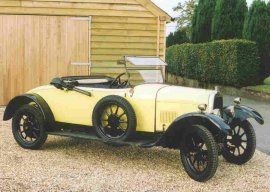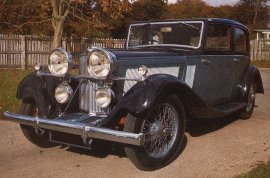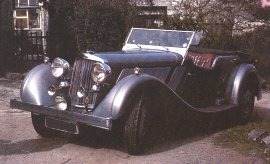
Arguably Roesch's greatest
achievement was to create the Talbot 10/23
from a little Darracq model...

A team of 3 Talbot 105’s would
enter the Coupe des Alpes Alpine trial
event; the team would suffer no penalties
and go on to a resounding victory...

The Talbot 105 Drophead Tourer was created
after the S-T-D combine had been broken
up...

After World War II Rootes would release
some sporting Sunbeam-Talbot's, but from
1954 the Talbot name was dropped once
again... |
Talbot was originally founded by the
Earl of Shrewsbury
& Talbot (hence the name), to assemble cars in London
from French components. Keen to become an entirely British
concern, in 1905 they replaced the original Clement-Bayard
models with home grown versions – cars that helped
Talbot gain a reputation for building durable, if somewhat
austere cars.
Amongst these first of these all “true”
Talbots was a four-cylinder 25bhp model, introduced
in 1908. A specially prepared version of this car was
stripped out for testing, and at the Brooklands track
Percy Lambert was able to become the first ever driver
(and therefore Talbot to be the first ever car) to
cover 100 miles in an hour!
During World War 1 Talbot made staff
cars and ambulances and, in 1916, they also gained the
services of Georges Roesch as their Chief Engineer.
Aged 22, Roesch had already worked for Gregoire, Delaunay-Belleville,
Daimler and Renault – a stunning CV to have at
such a young age.
After the war, Talbot merged with Darracq and Sunbeam,
becoming a part of the S-T-D combine, and this led to
Roesch becoming somewhat subservient to Sunbeam's noted
chief engineer, Louis Coatalen.
Talbot were to become
the poor cousin of the group, being forced to produce
some dull models; it says a great deal for Roesch that
during this time he was able to create the Talbot 10/23
from a little Darracq model – a stunning achievement.
Finally, in the mid-1920s, Roesch was given the freedom
to design a brand new Talbot. His remarkable, dynasty-founding,
14/45 six-cylinder model first appeared at the 1926
London motor show. Although its engine displaced only
1666cc, it was a highly efficient unit, with overhead
valve gear, whose rocker-gear was located on instantly
adjustable knife-edges. There was a very light flywheel
(which also incorporated a cooling fan), and this ensured
speedy throttle response.
Even though it was a substantial car, the 14/45 was
an overnight success, for it could exceed 60mph when
fitted with saloon car bodywork. Not only that, but
it laid the foundation for a succession of larger engined
Talbots. The first of these was the 75 (with 2276cc
engine), but the first of the the sporting Talbots was
the 90, whose engine developed 93bhp at 5000rpm.
It was this latter incarnation of the car that would
bring Talbot racing success, the most notable of which
was a third and fourth placing at Le Mans. Before you
brush off these placings as inconsequential, it is worth
noting that the Talbot’s were beaten by two 6.5
litre 'Speed Six' Bentleys.
Indeed this was to become
a recurring problem for Talbot, for although their cars
would always perform well, they were usually beaten
by cars afforded a much larger engine.
At the end of 1930, Roesch developed an engine which
was still based on the same overall dimensions and layout
as the 14/45 unit, yet had a capacity of 2960cc. In
touring trim the engine was good for 100bhp, but in
racing guise, and using a petrol-benzene fuel mixture,
the engine had around 140bhp on tap.
This new model,
named the 105, would take out third place at Le Mans
in 1931, and again in 1932. That same year, a team of
3 Talbot 105’s would enter the Coupe des Alpes
Alpine trial event; the team would suffer no penalties
and go on to a resounding victory.
In 1934, the ultimate derivative of the Roesch theme
arrived, the wonderful 3.37 litre “110”.
Based on the same engine layout, this mighty unit developed
123bhp in standard form, or up to 170bhp for racing.
A compact, and immaculately prepared, four-seater open
version was able to lap the Brooklands circuit at almost
130mph (209kmh), making it the very fastest touring
car to that time.
It seemed everything was going well for Talbot –
they were profitable, they had gained an enviable reputation
both on and off the track, and sales were very good
with almost 12,000 of the 14/45 and modernized 65 models
had been sold, together with appreciable numbers of
the larger-engined cars.
But Talbot were part of the
combine, and so when Darracq and Sunbeam collapsed,
having been hit hard by both the Depression and Coatalen's
over-spending on motor racing, Talbot were dragged down
with them.
Realizing Talbot were the jewel in the crown, the company
was speedily bought up by the Rootes Group, who also
purchased Sunbeam later in the same year of 1935. Initially
the new owners carried on building Roesch-designed cars,
but as the parts ran out, Humber components and engines
were used instead. Understandably Roesch left in disgust
and, in 1938, the famous marque fizzled out.
It is at this point that Talbot became a “Brand
Name” only for the Rootes group. They would go
on to combine the Sunbeam and Talbot names and use them
for up-market versions of Hillman and Humber cars. After
World War II, some sporting Sunbeam-Talbot 90s appeared,
but from 1954 the Talbot name was dropped once again.
Successors to those cars, such as the Alpines and Tigers,
were known as Sunbeams only.
Confused? Well there is one final twist! Tony Lago
would acquire both the business and naming rights for
Talbot, and so French carmaker Darracq was able to continue
to make its own versions of the sporting 'Talbots'.
Darracq would be swallowed up by Peugeot-Citroen in
1978, and would use the name on both some French and
UK built cars in the late 70’s and early 80’s.
Pass me an aspirin. |



